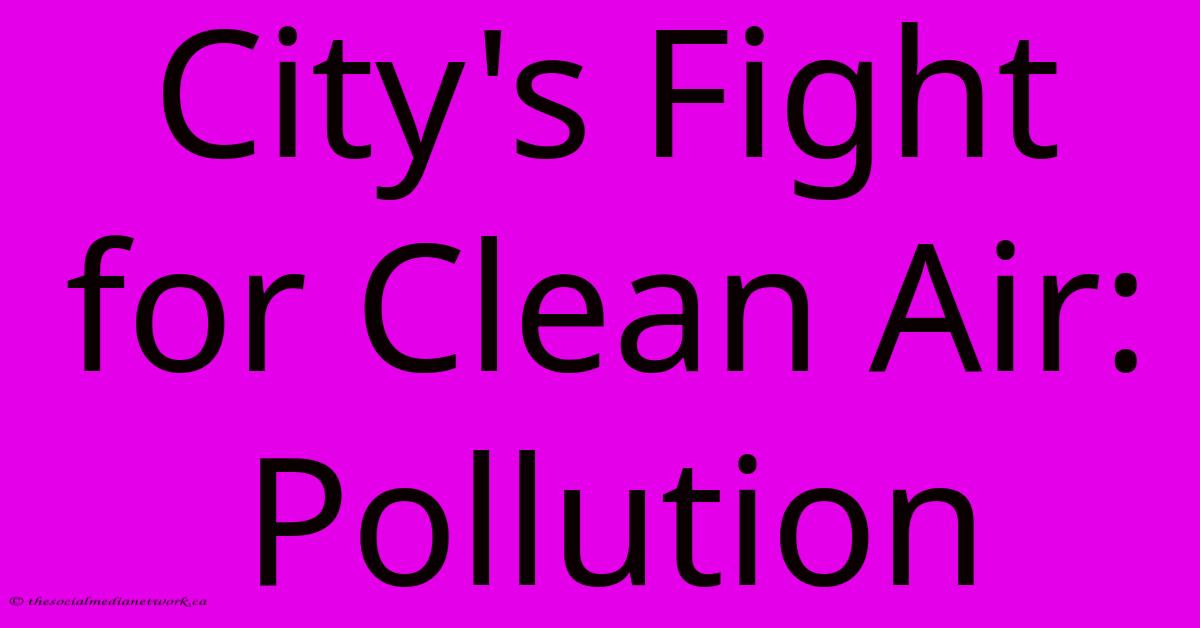City's Fight For Clean Air: Pollution

Discover more detailed and exciting information on our website. Click the link below to start your adventure: Visit Best Website meltwatermedia.ca. Don't miss out!
Table of Contents
City's Fight for Clean Air: Tackling the Pollution Problem
Our cities, vibrant hubs of human activity, are increasingly facing a silent killer: air pollution. From bustling metropolises to smaller urban centers, the fight for clean air is a critical battle impacting public health, the environment, and the economy. This article delves into the multifaceted challenges of urban air pollution and explores the strategies cities are employing to improve air quality and create healthier environments for their residents.
Understanding the Sources of Urban Air Pollution
Air pollution is a complex issue with numerous contributing factors. Identifying the primary sources is the first step towards effective mitigation. Key culprits include:
1. Vehicle Emissions: Transportation remains a dominant source of pollution, with cars, buses, and trucks releasing harmful pollutants like nitrogen oxides (NOx), particulate matter (PM2.5 and PM10), and carbon monoxide (CO). Older vehicles, congested roads, and a lack of alternative transportation options exacerbate this problem.
2. Industrial Activities: Factories and industrial plants, particularly those using fossil fuels, contribute significantly to air pollution. The release of pollutants like sulfur dioxide (SO2), volatile organic compounds (VOCs), and heavy metals poses a serious threat to air quality.
3. Construction and Demolition: These activities generate dust and particulate matter, which can easily become airborne and affect respiratory health. Poorly managed construction sites further amplify this issue.
4. Residential Energy Consumption: Heating and cooking using polluting fuels, especially in densely populated areas, can lead to significant air pollution levels, particularly indoors.
5. Waste Management: Improper waste disposal and burning of waste contribute to the release of harmful gases and particulate matter into the atmosphere.
The Impact of Air Pollution on Public Health and the Environment
The consequences of poor air quality are far-reaching and devastating. Exposure to air pollutants is linked to a wide range of health problems, including:
- Respiratory illnesses: Asthma, bronchitis, and lung cancer are significantly exacerbated by air pollution.
- Cardiovascular diseases: Air pollution increases the risk of heart attacks and strokes.
- Neurological problems: Exposure to certain pollutants can affect brain development and cognitive function.
- Increased mortality rates: Studies have shown a direct correlation between air pollution and premature deaths.
Beyond human health, air pollution also damages the environment. Acid rain, caused by sulfur dioxide and nitrogen oxides, harms ecosystems and buildings. Greenhouse gases from various sources contribute to climate change, further intensifying the challenges facing cities.
Strategies for Clean Air: A Multi-pronged Approach
Addressing urban air pollution requires a comprehensive and multifaceted approach, involving:
1. Investing in Public Transportation: Expanding and improving public transportation systems, such as buses, trains, and trams, encourages people to shift away from private vehicles, reducing traffic congestion and emissions. Promoting cycling and walking infrastructure is also crucial.
2. Enhancing Vehicle Emission Standards: Implementing stricter emission standards for vehicles and enforcing them rigorously will help reduce the amount of pollutants released into the air. Promoting the use of electric vehicles and hybrid cars is also vital.
3. Improving Industrial Practices: Implementing cleaner production technologies in industries and enforcing stricter emission regulations are crucial steps in reducing industrial pollution. Incentivizing industries to adopt green practices can also be effective.
4. Enhancing Urban Greenery: Planting trees and creating green spaces helps absorb pollutants and improve air quality. Urban planning should prioritize the integration of green infrastructure.
5. Promoting Sustainable Energy Sources: Switching to renewable energy sources for heating and cooking, such as solar and wind power, significantly reduces air pollution. Promoting energy efficiency measures also helps.
6. Raising Public Awareness: Educating the public about the sources and impacts of air pollution and promoting individual actions to reduce their carbon footprint are vital for creating a sustainable environment.
The Future of Clean Air Initiatives
The fight for clean air is an ongoing process requiring sustained effort, collaboration, and innovation. Cities need to adopt a long-term vision, incorporating air quality considerations into all aspects of urban planning and development. International cooperation and the sharing of best practices are also essential for tackling this global challenge. By implementing these strategies and fostering a culture of environmental responsibility, cities can pave the way towards cleaner, healthier, and more sustainable futures for all their residents. The battle for clean air is a fight worth fighting – for our health, our environment, and our future.

Thank you for visiting our website wich cover about City's Fight For Clean Air: Pollution. We hope the information provided has been useful to you. Feel free to contact us if you have any questions or need further assistance. See you next time and dont miss to bookmark.
Featured Posts
-
Monarchs Conclude Homestand Against William And Mary
Nov 26, 2024
-
Watch Monday Night Football Tonight
Nov 26, 2024
-
Top Court On Delhi School Reopening Air Purifiers
Nov 26, 2024
-
Gual To Deh Flood Sampan Transportation
Nov 26, 2024
-
Smart Water Market Aclara And Schneider
Nov 26, 2024
